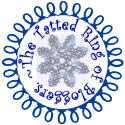Antique Pattern Library or through
Georgia’s site.
Deciphering really old tatting patterns is a challenge, complicated here by the fact that part of the introduction is missing. Even worse, Mrs Mee used terms which later came to have different meanings.

Her “pearl tatting” was entirely different from the pearl tatting technique we know today, as introduced by Mlle Riego a few years later in 1867.
Here is an excerpt from Mrs Mee’s book:
“PEARL TATTING. This is formed of 2 stitches, 1 single and the next take the upper thread and pass it over the pin towards you, passing the shuttle through between the 2nd and 3rd fingers as in single Tatting; the two stitches are required to make 1 pearl, counted as one, as in double stitch.
A pin and ring is often used, but the chain is in the way, and I much prefer a common pin of a good size as shown in the engraving.”
Today, we would say, 2 second part half stitches with a picot in between. We are used to half stitches giving a twist to the work, as in Victorian sets or spiral chains, but with this technique, the half stitches lie flat, and the twist transferred to the picots, giving a bit of a swirling effect. Subtle, but lovely, yes?

Oddly enough, I get the best results making the picots (pearls) freehand. When I try to make them over a pin as shown in Mrs Mee’s engraving, they just don’t work. I think passing the thread around the pin pulls the next half stitch forward enough that the picot does not take on the full amount of twist. I will have to study further to decide if the problem is my technique, thread size, or whatever.

However, if you use this stitch with a wider picot gauge, something AMAZING happens, just look:

I am using this stitch in some pattern I am writing now. The only question is deciding what to call it. If I say pearl, that might be too easily confused with pearl tatting. I could call them “Mrs Mee picots” though that’s a little cumbersome. Hmmm.
This is a snowflake adapted from a Mrs Mee pattern that I will be teaching at the Palmetto TatDays this fall:

By the way, thank you to everyone who responded to my last post about tatting notation. It was reassuring that so many of you agreed with the version I was thinking of using. On the other hand, I realized too late that though this solves the quandary of how to write the lines with special picot, that might force me to rewrite the rest of the pattern in the same style. I’m still thinking about that problem. I seem to get further and further behind on this project.
Oh, and don’t worry, that book (if I ever finish it) will have lots and lots of diagrams.









































maybe I am a little dense but I just don't get it, maybe some step by step pictures of how this is being done? I am just not understanding what is being done, how this is differing from a regular picot to get the twist in it other than the thread is twisted, which I am not understanding how to do...
ReplyDeleteMrs Mee's directions are thoroughly confusing to me. I sure am glad you were able to decipher them! I agree... that long picot does look amazing!
ReplyDeleteI'm not sure what you'd call the technique. What about giving a very brief description of Mrs Mee's picot in the introduction, and then assigning an acronym such as MMP?
I've gotten this swirly effect by using the shaft of a metal crochet hook as the picot gauge. I do the stitch normally but the continual forming of it over the shaft without moving it until a "row" or segment is done seems to give it consistent movement. I might have to try it as you say, with the same half stitch following and see what happens. Your pics are looking very enticing!
ReplyDeleteWhat a lovely technique! Another 'to-do'!
ReplyDeleteFox : )
What a lovely technique! Another 'to-do'!
ReplyDeleteFox : )
Amazing but looks hard although I do like the longer picots its going to take a lot a patice before I get it. Thanks for sharing its nice to see the old patterns coming out again.
ReplyDeleteMargaret
This stitch is beautiful - I love the swirling effect. You could call it Martha's Pearls :)
ReplyDeleteHave you considered calling it Bullion Picot? It reminds me a bit of cotton upholstery (Bullion) fringe.
ReplyDeleteVery interesting! I agree with Diane. I'm so glad you are figuring it out. I like Diane's acronym, too, or you could just call it the Mee picot.
ReplyDeleteI love the blue example.
ReplyDeleteAnother book on my must have list.
How about "Meecots"? Heehee!
ReplyDeleteJust a quick note to let you know that a link to this post will be placed on CraftCrave today [13 Jun 12:00am GMT]. Thanks, Maria
ReplyDeleteThat's a really neat effect. I can't wait to see what you do with it.
ReplyDeletesounds like Mrs Mee is making a Josephine knot with picots between the half stitches. very interesting techniques. I have often wondered what would happen if you put picots in a josephine knot, just never put that many in to see the effect. Good for Mrs Mee
ReplyDeleteMeecots! LOL -- Erin, you've hit upon a very clever name indeed!
ReplyDelete